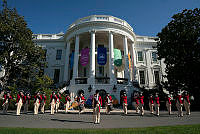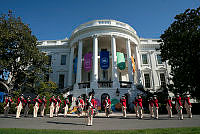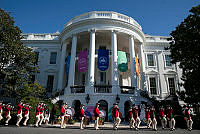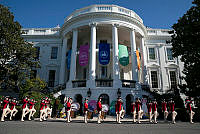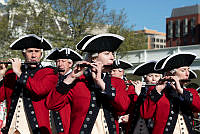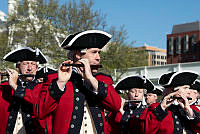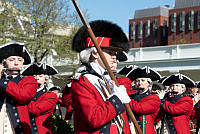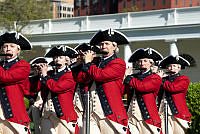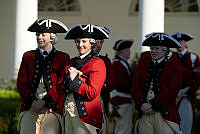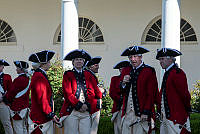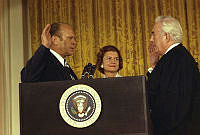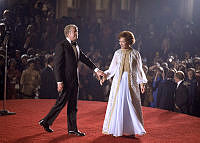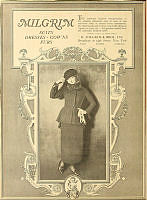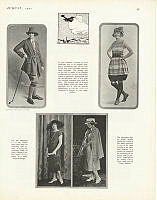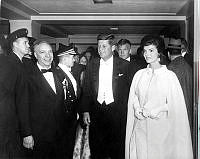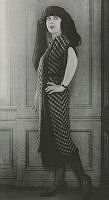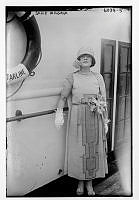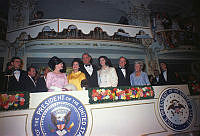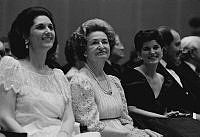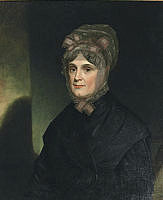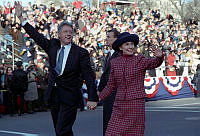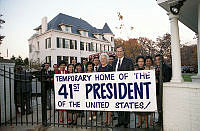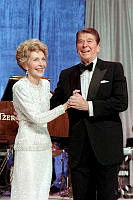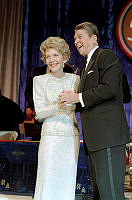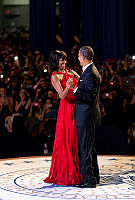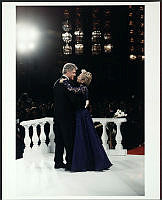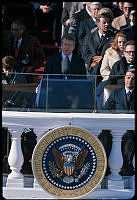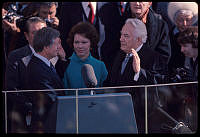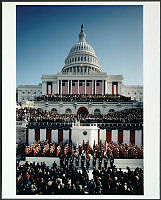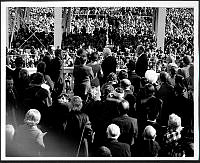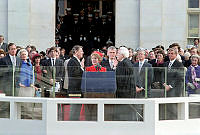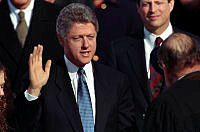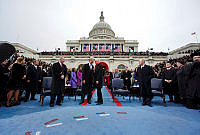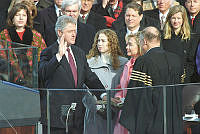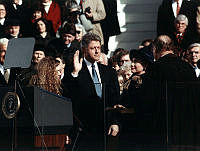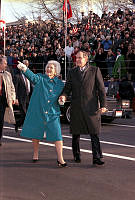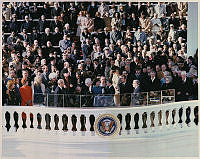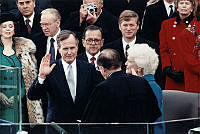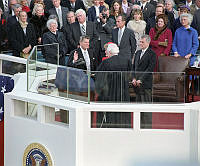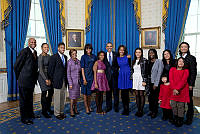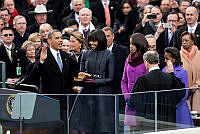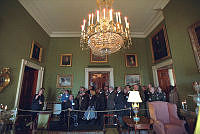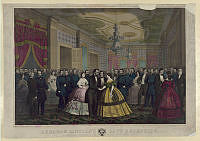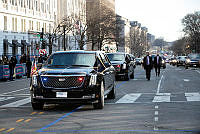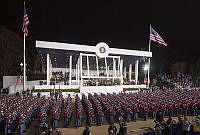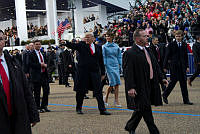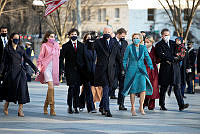Afternoon Accolades
A Cultural History of White House Inaugural Reviewing Stands
Copyright © Fall 2004 White House Historical Association. All rights reserved under international copyright conventions. No part of this article may be reproduced or utilized in any form or by any means, electronic or mechanical, including photocopying, recording, or by any information storage and retrieval system, without permission in writing from the publisher. Requests for reprint permissions should be addressed to books@whha.org
Since the second inauguration of Ulysses S. Grant in 1873, inaugural reviewing stands— temporary pavilions built in front of the White House for an afternoon’s use—have provided most new presidents the pleasure of reviewing the armed forces of the United States following the inaugural ceremony at the Capitol.1 Over the years the reviewing stands have become more elaborate, as have the inaugural parades, which, soon after Grant’s time, were expanded to include civilian groups and floats.
The predecessors of the inaugural reviewing stands at the White House were two stands used to review Union troops during the Civil War era. The first was a very simple wooden platform, covered with a canvas canopy, which was used to review the New York troops stationed in Washington on July 4, 1861. The stand stood on the curb of Pennsylvania Avenue with the White House in the background.2 Maj. Gen. Charles W. Sandford led the 29 New York regiments, totaling more than 20,000 soldiers, past the reviewing stand occupied by President Abraham Lincoln, his cabinet, army officers including Lt. Gen. Winfield Scott—the infirm commanding general of the U.S. Army, then 75 years old—and several distinguished civilians. The soldiers removed a green sprig from their hats and threw it at the feet of the seated figure of General Scott in tribute to the old hero. In addition the captains of each company in the procession threw a bouquet of fresh flowers onto his lap. It is not recorded how General Scott could see at the end of the parade, so heaped he must have been with flowers.3
Short speeches, all expressing pride in the rapid mobilization of New York volunteers for the defense of Washington, D.C., were made by Lincoln, three cabinet members, and three generals. Then the 71st New York Regiment formed a guard of honor in front of the north end of the Treasury Building. After Lincoln raised the U.S. flag on a 100-foot-high flagpole, the military presented arms and the band played “The Star-Spangled Banner.” The morning’s festivities concluded with nine cheers for the flag, nine cheers for Lincoln, and nine cheers for Scott. It was the largest review of troops up to that time in the city’s history.4 Less than two weeks later these Union regiments and many others advanced into Virginia and were defeated by Confederate forces at the first battle of the Civil War, the First Manassas, 27 miles southwest of Washington.

President James A. Garfield in his reviewing stand, viewing the inauguration ceremonies, on March 4, 1881.
Library of CongressOn the second occasion, President Andrew Johnson, elevated to the presidency following Lincoln’s assassination, reviewed victorious Union armies on May 23-24, 1865, before their retirement at the close of the war. His reviewing stand and three adjacent stands, numbered 1, 2, 3, and 4, were located on Pennsylvania Avenue in front of the White House and across the street in Lafayette Park. The principal stand, number 1, held the president, his cabinet, Gen. Ulysses S. Grant, the heads of both civil and military departments, and the diplomatic corps. Stand 2 was reserved for governors of Union states, members of Congress, and judges. Wealthy private individuals erected stands 3 and 4 both for the use of themselves, their families, and their friends, and for wounded Union soldiers from local military hospitals. Members of the press were present in all four stands.5
Only six days were available for constructing these stands after Secretary of War Edwin Stanton announced, on May 18, 1865, that the president would review the three major Union armies before they were disbanded.6 Stanton based this first national review of the U.S. armed forces on the grand reviews that Napoleon I held in Europe after major victories as well as on the grand reviews held by both British and Russian generals in Paris in 1815 after they defeated Napoleon at the battle of Waterloo in Belgium.7
Beginning at 9:00 a.m. on the first day of “The Grand Review of the Armies of the Union,” Gen. George G. Meade led his 80,000 soldiers of the Army of the Potomac from the Capitol down Pennsylvania Avenue past the White House to Washington Circle, where they returned to their encampments in Virginia. Various units of the army marched together, including the artillery, signal corps, ordnance, medical, cavalry, quartermaster, infantry, engineer corps, and dozens of regimental bands. When this six-hour procession first reached the White House, Gen. William T. Sherman dismounted from his horse, Blackie, in front of stand 1 and joined President Andrew Johnson and General Grant for the review. The stands were decorated with both U.S. and army battle flags, while the names of 10 major battles, including Gettysburg, Petersburg, Richmond, Vicksburg, and the Wilderness, were displayed at the top of the stands. A large star made of flowers and evergreens was mounted at the center and ends of each of the simple open wooden stands.8

For James A. Garfield's inaugural in 1881, a wooden arch was erected at 15th Street and Pennsylvania Avenue.
Library of CongressOn the second day General Sherman began the parade with 65,000 soldiers led by Gen. John Logan of the Army of the Tennessee and Gen. Henry W. Slocum of the Anny of Georgia. There was a marked difference between the soldiers of the Army of the Potomac, conveniently based in nearby Virginia, who were refreshed and better dressed than the soldiers from Tennessee and Georgia, who were exhausted from their rapid march, hundreds of miles from the Deep South, to Washington. Their uniforms were tom and their battle flags freshly rent by bullets. But now the officers and their horses were showered with flowers, tossed by the thousands of spectators lining Pennsylvania Avenue. When both parades started, hundreds of public school children from Washington sang patriotic songs, including “Rally ’round the Flag” and “When Johnny Comes Marching Home,” on the lawn of the Capitol.9
Fifteen years later, the nation faced another trauma—the presidential campaign of 1880—one of the most bitterly contested elections of the century. The Republican Party was divided at its convention. With the balloting deadlocked between Grant, a conservative attempting an ill-fated comeback, and James G. Blaine, a liberal, the solution was to nominate James A. Garfield, a dark-horse candidate from Ohio, to whom Blaine votes were switched. To please the conservative faction, Garfield selected as his running mate Chester A. Arthur of New York, who opposed Civil Service reform. The campaign between Garfield and Democrat Winfield S. Hancock, a prominent but dull Civil War general, was characterized by bitter personal attacks on each candidate, because no real issues were involved. Garfield won the election by an extremely narrow margin of fewer than 10,000 votes out of 9 million cast.10
Garfield’s inaugural parade, on March 4, 1881, was one of the most spectacular ever held. The elaborate preparations included the construction of 39 large wooden arches, of a design that might be called “Teutonic,” at every intersection on Pennsylvania Avenue between the Capitol and the White House. Named for the then 39 states of the Union, they were grouped in conciliatory pairs of a northern state and a southern or border state. The 70-foot-high principal arch, painted a bronze tint, straddled 15th Street between Pennsylvania Avenue and F Street. The use of flags and bunting for decoration was considerable; most of the buildings on Pennsylvania Avenue, including the Willard Hotel, had every window draped. Streetcars, carriages, and wagons were also covered with miles of crepe. The White House itself was decorated to such an extent that its front facade could hardly be seen.11

President Theodore Roosevelt's reviewing stand for his inaugural parade, March 4, 1905.
Library of CongressGarfield’s open-air inaugural stand was the first recorded by a camera. Draped with four large American flags, it was crowned by a prominent, freestanding four-foot-tall eagle and shields on the comers. The two-hour parade included 15,000 marchers. Next to Garfield were his wife and two sons and behind him his mother. On his left were former President Rutherford B. and Mrs. Hayes, Garfield’s new cabinet members, several governors, and many Civil War generals, including Sherman.12
After 1881, the modem inaugural parade rapidly developed as we know it today. Less importance was placed on military forces and more emphasis on civilian participation, with hometown bands, veterans’ groups, Indian delegations, and floats. In 1893, for instance, floats were added, as were lively stunts and a replica of the U.S.S. Constitution, which, dating from the War of 1812, was the oldest surviving warship in the U.S. Navy. Special effects were tailored to each president. In 1933, for example, a band played the “Franklin D. Roosevelt March,” composed especially for FDR by Treasury Secretary William H. Woodin.13 Until the early 20th century, public reviewing stands for inaugural parades were erected in front of shops along Pennsylvania Avenue by the merchants, who sold tickets to the spectators. By World War I the winning political party paid for the public stands and determined their design.14 Since the 1950s, designs for most of the reviewing stands have been selected by the American Institute of Architects (AIA), in coordination with the official inaugural committee in open architectural competitions.
After Garfield, many of the White House inaugural stands became much simpler designs—often plain wooden open-air platforms draped with American flags. Examples are Grover Cleveland’s stands for 1885 and 1893. Even the simple stands varied, however, and some reflected the president’s personal preference. The 1893 stand for Cleveland, seating 1,100, was double the size of that used for President Benjamin Harrison in 1889. In addition to the usual U.S. flags and national anus, Cleveland’s second stand had a large coat-of-arms of New York, the president’s home state, and that of Illinois, the home state of Vice President Adlai E. Stevenson. Below these were the arms and dates of the admission of the 13 original states.15

Photographers in place at President Taft's inauguration.
Library of CongressTheodore Roosevelt’s inauguration in 1905 had an unusually festive appeal. His handsome reviewing stand and similar stands between 15th and 17th Streets were first termed the “Court of Honor.” Statues of famous figures from American history from the 1904 Louisiana Purchase Exposition in St. Louis were displayed in the Court of Honor and along nearby Washington streets. Pennsylvania Avenue was lined with grandstands and 50,000 American flags. During the three-hour parade—one of the most spectacular in Washington history—35,000 marchers passed before Roosevelt, whose buoyant personality was evident in his excitement. Among the colorful marchers were coal miners with their miners’ hats, Indian chiefs including the Apache warrior Geronimo on horseback, cowboys, and Rough Riders from the Spanish-American War. Roosevelt waved, shouted, and swayed to the music from dozens of bands.16
Roosevelt’s tiered reviewing stand, in the elegant neoclassical style, was open, the roof supported by alternating single and double columns. The presidential party occupied a small pavilion that protruded in front of the main grandstand. Seven American flags clustered together behind an American shield decorated the top of the pavilion, while a balustrade of pierced neoclassical grills ornamented the base.
Another distinctive White House reviewing stand was the one designed by prominent Washington architect Waddy B. Wood for President Woodrow Wilson’s 1913 inauguration. A two-story high white neoclassical portico with balcony dominated the Court of Honor. Among the 6,000 “college men” who marched were 1,000 Princeton University students who gave “college yells” for the president. Wilson had served as president of Princeton before entering politics. Orange and black streamers, the colors of Princeton, were evident all along the parade route.17 Dwight D. Eisenhower was among the West Point cadets whom Wilson reviewed. The rather staid Wilson vetoed the traditional inaugural ball, replacing it with a fireworks display on the Ellipse.18

Woodrow Wilson’s reviewing stand in 1913 was inspired by his boyhood home in Staunton, Virginia.
Library of CongressA similar reviewing stand—a two-story neoclassical portico with four columns, projecting over the center of the main rectangular stand—was used in 1917 for Wilson’s second inauguration. Between the two central columns was a projecting octagonal glass booth. The design of these two stands with the classical portico reflected Wilson’s southern heritage and in particular his birthplace in the Presbyterian manse of a similar design in Staunton, Virginia. The railing along the roof was reminiscent of the railing then in place above the portico of Mount Vernon.19
The threat of America’s entry into World War I, which occurred a month later, put a damper on the ceremonies. Only half the number of people who attended Wilson’s first inaugural parade were in the crowd in 1917. In addition, security measures were necessary. Armed guards were on rooftops, and machine guns were positioned at the Capitol.20 Young Franklin D. Roosevelt, then Wilson’s assistant secretary of the navy, was seated in the open behind Wilson’s “glass cage,” which provided protection from the strong wind. FDR disapproved of Wilson’s maintenance of U.S. neutrality in light of German attacks on American ships; Roosevelt also considered hiding behind the glass enclosure to be unbecoming to a commander in chief.21
The reviewing stand for Calvin Coolidge’s inauguration in 1925 was unusual, both in its simplicity (perhaps because of the president’s frugal Vermont background?) and in its shape. The front of the six-sided, glass-enclosed structure consisted of a projecting three-sided bay, the center of which was open to allow the presidential party an unobstructed view of the parade. The base was decorated with ropes of greenery and the presidential seal, while the American shield crowned the cornice. Coolidge found the one-hour parade an ordeal. His dour personality put a damper on the ceremonies.22 Departing from recent tradition, he banned most political and fraternal organizations from the brief review and emphasized the military. No inaugural ball was held. “Silent Cal’s” influence made his inauguration the most boring in the 20th century.23

President and Mrs. Herbert Hoover in the reviewing stand, watching soldiers march by during the inaugural parade, March 4, 1929.
Library of CongressThe inauguration of Herbert Hoover on March 4, 1929, was much more festive. The Hoovers had to change clothes before entering the reviewing stand because they were drenched by rain on their return from the Capitol in an open car. Their stand was different from any other, with a striped roof on the projecting central bay of windows. Behind and above the curved bay was a simple gabled facade decorated with green latticework— all reminiscent of a garden pavilion on a Palm Beach or Southampton estate. The two-hour parade of 20,000 marchers, included President Coolidge’s son, Maj. John Coolidge, who marched with his Connecticut militia regiment.24 Notable groups included the United Confederate Veterans, marching in an inaugural parade for the first time, and a group of Australian cadets marching to recognize Hoover’s work in Australia as a mining engineer.25
The most festive inaugural parades since Hoover’s include those of Franklin D. Roosevelt in 1933, John F. Kennedy in 1961, and Ronald Reagan in 1983. The first inauguration of FDR on March 4, 1933, featured a reviewing stand with a two-story neoclassical portico, a cupola, and a sculpted pediment. It resembled Federal Hall, the building designed by Peter Charles L’Enfant as the first capitol of the United States, where George Washington took the first oath of office in 1789. Washington architect Waddy B. Wood again served as the designer. Roosevelt, his family, and his cabinet occupied a small open booth built in front of “Federal Hall.” Costing $100,000 to construct, it was the most expensive reviewing stand to date. Other decorations in the Court of Honor included statues of George Washington and Thomas Jefferson on the north side of Pennsylvania Avenue, opposite the president.26
As grand marshal of the 1933 parade, Gen. Douglas MacArthur assembled it for first time on Constitution Avenue near the Capitol, before beginning on the Pennsylvania Avenue route. Roosevelt arranged for 300 members of the Electoral College to join the march to remind Americans of the importance of the electoral votes in addition to popular votes. (FDR and his running mate, House Speaker John Nance Garner of Texas had won 57 percent of the popular vote and taken the Electoral College by the astonishing ratio of 8 to 1.) The four-hour parade was witnessed by 500,000 spectators, then the largest crowd in Washington history.27

The inaugural stand built for President Franklin D. Roosevelt in 1933.
Library of CongressFranklin D. Roosevelt’s second inaugural was held on January 20, 1937, rather than on the original date of March 4. The change was made by the 20th Amendment to the Constitution to avoid “lame duck” sessions of Congress. The 1937 reviewing stand was even more spectacular than that of 1933. Again architect Wood was commissioned to design the stand—this time a replica of the six-column neoclassical portico of the Hermitage, the plantation house in Nashville of Andrew Jackson founder of the Democratic Party. Roosevelt had the bulletproof glass of the presidential booth removed just before the parade began. In contrast to his first inaugural, which was clear and windy, conditions in 1937 were miserable, with freezing rain throughout the day.
Roosevelt decided not to cancel the parade, however, as many thousands of marchers had come to Washington for the event.28 While the 1937 reviewing stand was outstanding in design, the parade was much more subdued than the 1933 extravaganza, just one and one-half hours and restricted to units of the armed forces and state militia. Roosevelt’s third inaugural parade, in 1941, was equally restrained because of the threat of war with Germany and Japan. This short parade was again composed of military units, with a massive display of 235 army and navy airplanes overhead. The three Japanese diplomats attending rose to their feet for a closer look each time a wave of heavy bombers came in low over the “Court of Freedom,” as the space around the presidential inaugural reviewing stand in front of the White House was then styled. Roosevelt’s modest reviewing stand was only large enough for a dozen people to occupy. The parade was watched by a number of refugees from war-tom Europe, including the children of the royal family of Norway.29
Harry S. Truman’s 1949 inaugural reviewing stand was one of the first selected from a competition organized by the American Institute of Architects (AIA). Architect Branch D. Elam won the competition on December 14, 1948.30 In 1953, Dwight D. Eisenhower’s stand was designed by Robert Weppner, an architect and faculty member of Catholic University, who won the AIA competition. Consistent with the prevailing fashion of abstract modem architecture, in which “less is more” as proclaimed by Ludwig Mies van der Rohe, the stand consisted of four slender pillars set between and below a plain, flat facade with no decoration.31

This inaugural stand built for President Harry S. Truman in 1949 was designed by architect Branch D. Elam.
Library of CongressThe parade, however, was spectacular, as Eisenhower’s was the first Republican inauguration in 24 years. The elaborate procession cost a record-setting $1 million and drew a record crowd of 750,000 spectators. Of the 43 floats in the parade, 10 represented scenes from Eisenhower’s life. These included a replica of the Texas house where he was born; the dairy where he had his first job; West Point, where he was a cadet; and various scenes from his marriage and his career in World War II. Even though Mrs. Eisenhower had to sit down and remove her shoes because of swelling feet, the president remained standing through the five-hour parade. For the first time, the number of American flags in the parade was limited, thus relieving the seated viewers in the executive reviewing stand from constantly having to stand up and salute. Eisenhower greatly enjoyed the parade. He even allowed a famous cowboy, Monte Montana, to lasso him. The solemnity of the military units was balanced by the circus-like character of other parade participants, including dog acts, trained seals, dancing horses, and three elephants.32
A sharp departure from the style of previous reviewing stands was the Kennedy structure of 1961, designed by Washington architect Robert Paul Brockett. He won a competition held by the AIA from among members of 38 its Washington, D.C., chapter. One knew that 20th-century architecture had arrived with this open pavilion, its flat roof tilted upward toward Pennsylvania Avenue. Its ceiling was decorated with an enormous presidential seal, surrounded by square skylights. The four rows of narrow, flat-sided piers supporting the roof contributed to its austerity.33 After the inauguration the seal was purchased by the owner of the Occidental Grill, a Washington restaurant adjacent to the Willard Hotel, and used to decorate the Occidental’s ceiling.34
The 1965 inaugural stand of Lyndon B. Johnson was heavily guarded because of the recent assassination of President Kennedy. Added security required the placement of 5,000 guards along Pennsylvania Avenue, the closure of all windows facing “the Avenue,” and the inspection of all rifles carried by the military in the parade to ensure that they were empty of shells. The four Cochiti Indians in the parade even had to remove the steel tips from their arrows. The number of military units was reduced to allow a better balance for floats.35 Johnson’s stand was bomb proof and bullet proof. Its design came from the drafting board of architect Peter Hasselmann, who was selected by the American Institute of Architects.36 The unusual design consisted of tapered piers, which flared outward at the top, supporting a flat roof with a broad cornice that matched the balustrade below. The heaviness of the base and top reflected the modem style referred to as “Brutalism,” which was also used in the design of the J. Edgar Hoover Federal Bureau of Investigation Building, then under construction at Pennsylvania Avenue and Ninth Street.

President John F. Kennedy's reviewing stand, 1961.
National Archives and Records AdministrationJimmy Carter broke with the by then traditional method of having the AIA choose the design for the inaugural stand. For his 1977 inauguration, he selected Atlanta architects Paul Muldawer and Jim Patterson to design a stand that reflected his concerns for ecology, natural resources, historic preservation, and energy conservation; consequently, this stand was heated by solar energy. For the first time this small unassuming stand was set at an angle that allowed the White House to be seen by the marching units—and TV crews. The low stand included a wide cornice and a projecting central pavilion for the president, with the presidential seal hung overhead.37
The simple, open, but unusually tall reviewing stand used by President Ronald Reagan in 1981 was important because the same basic design was used for the next three inaugurations. It had a pair of rectangular pillars on each side of the front. The presidential platform in the wide-open central section, decorated with the presidential seal, extended forward into Pennsylvania Avenue. Two more sets of shorter piers supported the sloped roof in the middle and rear of the stand. More than 300,000 spectators lined Pennsylvania Avenue on the warm, sunny day of the inauguration, which was held on the west front of the Capitol for the first time. This location allowed much greater space for spectators. Reagan obviously enjoyed the parade from the reviewing stand; he sang and clapped with the rhythm of each band. In addition to the music Reagan appreciated seeing the 450 horses that paraded by. The Mormon Tabernacle Choir concluded the parade by serenading President and Mrs. Reagan in the reviewing stand.38
As this brief survey of the presidential inaugurations testifies, the White House inaugural reviewing stand has become an important part of the American inaugural tradition, which offers incoming presidents the beginning of the “honeymoon” as the new administration begins to function. Party politics and political animosity are set aside for this national celebration of democracy in action. Whether elaborate or simple, the reviewing stands have each offered our incoming presidents a wonderful sense of mission accomplished in achieving the highest office in the land. Indeed the thousands of marchers provide an afternoon of accolades not easily forgotten.



